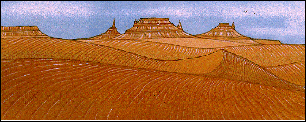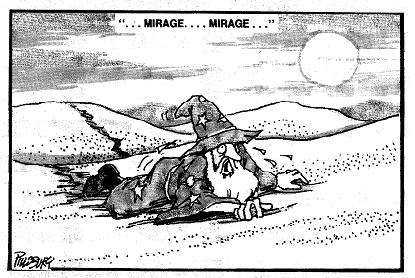Desert

* The technical definition of a desert is
any AREA that receives 10 inches of rain per year; <or less>
in actuality, the yearly rainfall in most
deserts might be half that amount or even less.
* Where sand is abundant and the wind is
at least occasionally very strong,
dunes can grow to be more than 500 feet
high.

-
|
Cold Civilized
Desert
|
Temperate Civilized Desert
|
Tropical Civilized Desert
|
|
Cold Wilderness Desert
|
Temperate Wilderness Desert
|
Tropical Wilderness Desert
|
|
-
|
Sargonnas
(god of deserts)
|
-
|
Not all deserts are covered
with sand, and not all of them are in hot climates, but every desert has
one thing in common with all the others: They are very, very dry.
The technical definition of a desert is
any AREA that receives less than 10 inches of rain per year; in actuality,
the yearly rainfall in most deserts might be half of that amount or even
less.
The lack of moisture
in a desert does not render the AREA totally barren or uninhabitable.
Many plants & animals are naturally
able to cope with a severe shortage of water;
the cactus and the camel are perhaps the
best-known examples.
However,
characters are not so fortunate;
they need water
frequently and in fairly large amounts,
and the best way to satisfy this need during
a trek across the desert is to carry a supply of drinking water
(or the means to produce water magically).
Although it is possible to find water in
the desert, either by stumbling across an oasis or by digging for ground
water,
neither of these methods is especially
reliable.
Most deserts are composed
of {dry}, hard-packed earth beneath
a layer of gravel, with the terrain occasionally
broken by a clump
of large boulders. Water
can be particularly difficult to find in this
kind of desert terrain, because the rainfall
tends to run off the surface
(flowing toward a place of lower elevation)
instead of soaking
into the ground. Relatively few deserts
are covered with sand,
which does permit water to soak into the
terrain from where it can
be recovered later.
The icy wastes of the polar regions can
also be considered deserts.
In a desolate place such as the arctic
north, vegetation and
animal life are even more scarce than in
a desert located in a hot
climate. Although moisture is abundant
on the ground (in the
form of ice), the terrain still qualifies
as desert because it receives
very little precipitation.
On a sandy desert, dunes are formed by the
action of the wind;
their shape and size depend upon the amount
of sand and the velocity
of the wind that moves it around. Where
sand is abundant
and the wind is at least occasionally very
strong, dunes can grow
to be more than 500 feet high. The slope
gradually ascends in the
direction of the wind. From the peak of
the dune, the sand slopes
down sharply on the side opposite the wind
direction. In a very active
wind, the peak of a dune can move several
hundred feet in
only a day or two; as windblown sand cascades
down the slope
away from the wind, that side of the dune
becomes able to support
more and more sand, and eventually the
dune peaks at a
point farther downwind. Where the supply
of sand is smaller and
the wind is less intense, dunes are correspondingly
smaller and
shorter. In fact, the technical definition
of “dune” is an accumulation
of sand, formed by wind action, that is
no more than 70 feet
high. Anything larger is properly called
a sand mountain, or
“draa.”

An object (or a character) that remains
in one spot for any great
length of time in a desert with heavy sand
cover may end up buried
under tons of sand. On the other hand,
the action of the shifting
sands may uncover the entrance to the hidden
temple that
you’ve been searching for. . . .

<examples:
arctic:
subarctic:
temperate: Gobi desert
subtropical:
tropical:>

*template***template*

